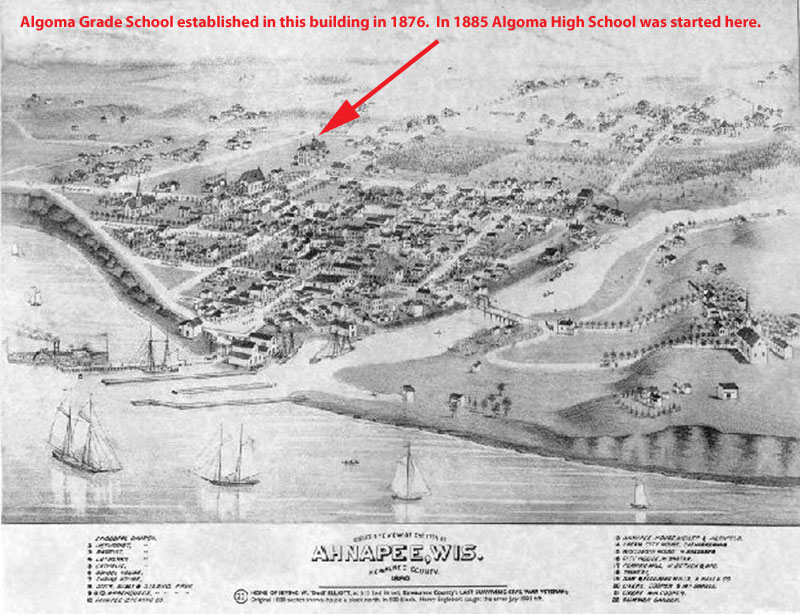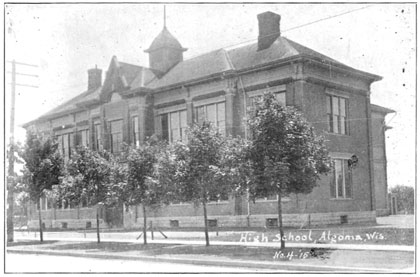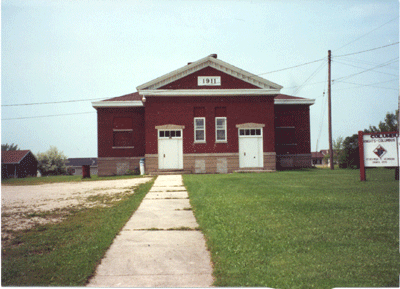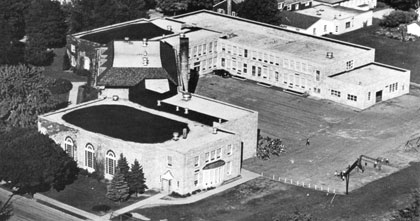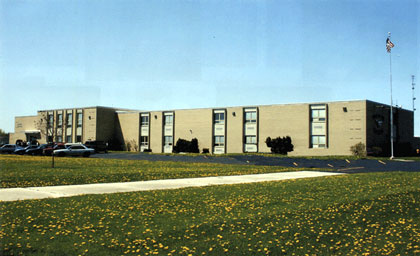Graduated Classes
Class
Reunion Info
Algoma Pictures
Search
Related Links
Credits
About Us
Contact
Us
|
History of the Algoma Public School System Alma Mater Other school songs View All Algoma High School Annual Covers Here |
||||||
|
The education of children had been an important part of the culture of Europe. The Pioneer immigrant settlers of Ahnepee (the first name of the early settlement, later Ahnapee, and finally Algoma) brought that coveted mission with them and were quick to establish this essential prerequisite for the future success of their children. Under the School Law of 1848, free education was supposed to be available to all children between the ages of four and sixteen years. The law did not specify a language until 1854 when a new law specified that the course materials be taught in English. Since many early settlers came from other areas of the United States and spoke English, their immediate goal after they settled in Ahnapee in the 1850s was to find a teacher and a place to hold classes. Although the various early accounts on the subject of schools are somewhat confusing, M. T. Parker, in his serialized, “Historical Sketch of the Town of Ahnapee,” published in the Ahnapee Record between July and November 1873, tells us that the first building used as a classroom was a log shanty on the north side of the river. The year was 1855. This was not a public school in the strictest sense because it was formed by the families who lived in the nearby surrounding area on the north side. The first teacher hired by the families was Miss Parker who later became Mrs. George Fowles. M.T. Parker goes on to say that the first building erected in Ahnepee as a public school was a small frame building on the north side, built in 1856. This school was located on the bluff overlooking the lake, just north of the house occupied by the lighthouse tenders, on what is now County Highway S. The teacher was Mrs. Sanborn, a widow who lived in Door County. This school was replaced a few years later with another, larger frame building across the road from the earlier structure. The first school would later become the residence of Edward Harkins. In 1858, the residents on the south side of the river rented a small, one-story building at the foot of Steele Street for a schoolroom and hired Miss Irene Yates as their first teacher, succeeded shortly afterwards by Mr. Ward. A year later, the newly established school district decided a more permanent school was needed, and in 1859, built a frame schoolhouse on the northeast corner of Fremont and Fourth streets. Miss Parella Wagner was the first teacher with Mrs. Stebbins suceeding her. When this school was built, in what was then a clearing with stumps and logs and a high board fence around it, many settlers complained that the building was too far back in the country. They were concerned for the safety of their children during the long trek to school through the wilderness. The children from Bruemmerville, the Hall Mill settlement about two miles to the west, even had to carry their dinners (lunch) to school. The complaining did not accomplish much and by 1866, when another school was opened because of a rapidly growing population, new settlers had filled in many of the empty spaces on the surrounding land. A familiar pattern had thus been established. The paint on the new school had hardly dried when enrollment increased to warrant greater space – or a new facility. Meanwhile, two parochial grade schools had been established in the early 1860s by the Lutheran and Catholic congregations and served a dual purpose as church and school. Both were initially located on the north side within sight of each other on Church Road. Over the following years, each of them relocated several times when new schools were built, but they remain a vital and integral part of the Algoma Public School system. Due to the ever increasing population growth, the school district reorganized in 1875 and built a new frame schoolhouse in 1876 on the corner of Fremont and Sixth Street, in front of what is now the Algoma Elementary School. The small two-story building had a large copula on top. It was pink in color, which sounds odd, but that is how students who attended described it. This school was called the Algoma Graded School because it was solely used for grades one through eight.
In 1885, the school was reorganized to include a three-year high school with students being enrolled in the fall of that year. There were two graduates of that first class who received their diplomas in the spring of 1888: Hannah Marr, who married John Empey (who became a prominent Algoma gentleman), and Lottie Teweles, who later moved to Milwaukee. There were no graduates for school years 1889 and 1890, but there were four who graduated in 1891 and five for 1892. The high school had no graduates in 1893 because the school had changed to a four-year course and graduated four students of the new course in 1894. Algoma High School has graduated students each year since then. In 1895, an addition was built on the back of the school to accommodate an increasing student population. But that didn’t solve the continuing need for more space, so a new public school was built in front of the old school in 1906. The new school doubled the size of the old, but still housed both grade and high school students. Also of frame construction and completed in 1886, this new section was painted white. There are no known photos of the school as it looked in 1886.
The next change of note was the formation of the seven member school board in 1908. Over the years the board imposed numerous restrictions on students and school activities, which were not, at first, welcomed or universally embraced. The board forbade any person to teach in the school who was connected to any member of the board by family ties. The board also required all teachers to complete a full Normal Course. In retrospect, the seven member board aroused interest in the school and this spirit continued to grow during the ensuing years. Door-Kewaunee Training School opened in 1908 in the south and west wings on the 2nd floor of the old 1876 schoolhouse. The name would later be changed to Door-Kewaunee Normal School. This joint training school was a collaborative effort of the county boards of Kewaunee and Door Counties and was a very important link in the educational system in northeastern Wisconsin in the early years of the 1900s. The school trained new teachers for the numerous rural grade schools located throughout both counties. Fifty-two students were admitted and nine were turned away because of a lack of space. A new grade school, Irving Demonstration, was built on the north side in 1911, relieving the pressure on the combined downtown school and served the rural areas to the north and northwest of the city.
In April 1912, the Bank of Algoma sold the old Dormer House hotel (Lots 1 and 2) to the newly named Door-Kewaunee Normal School. In May 1914, August Froemming sold Lots 4, 5, and 6 to the school for a planned expansion of both the school and dormitories. By 1920 Algoma had grown into a thriving city that had experienced tremendous growth. Now a city of two thousand inhabitants, there were amenities that many similar-sized cities could not claim. It had become the educational center of Door and Kewaunee counties with the addition of the joint-county training school. In addition to the teaching school, it had five schools within the city limits: two graded; two parochial; and a thriving high school. In addition, there were several educational-recreational facilities in the form of a very modern movie theater and an Opera House. The school built in 1906 had experienced larger student enrollments as growth continued, but was in disrepair due to poor maintenance practices by the time of the Great Depression that began in October 1929. As part of the Public Works Project program instituted by the Franklin D. Roosevelt Administration, Algoma was eligible for help in building a new public school housing both the grade and high school in 1934. The design of this new two-story building included updated features that included an ornate auditorium on one end; a full-court gymnasium on the opposite end; a kindergarten room with functioning fireplace and child-sized bathroom; and a music room with soundproofing. Additional land was purchased to the west of the old school and that is where the new, much larger, school was built. The grade school occupied most of the ground-level classrooms with the high school on the second floor. This new school was dedicated on the evening of 20 September 1935 by local dignitaries with an audience that packed the new auditorium. (Please go to the 1936 Annual for more information on the dedication program and ceremony.)
New Algoma High School completed in 1935 shown in this photo taken in 1938 In 1938, the Door-Kewaunee Normal School was destroyed by fire and the dormitory was used for classrooms until a new building could be constructed on the site. Ground was broken in June for the new school that would include many updated features. The exterior was very similar to the new Algoma High and Elementary school only a few yards to the west. A consolidation of school facilities began during WWII to decrease the expense of maintaining various district schools with declining enrollment. Irving Demonstration Grade School discontinued grades seven and eight at the end of school year 1946, but the building continued to be used by Door-Kewaunee Normal School as a student teaching lab. Seventh and eighth grade students from that school transferred to one of the two parochial schools or to the public grade school. Many of the other rural elementary schools throughout the county were also closed and the students were bused to the schools operated within the cities and villages. This was just the beginning of many future consolidations.
1950 Aerial view of AHS showing the auditorium and
gymnasium wings not shown on the above photo.
However, the consolidations caused a new problem. In 1955, a wing was added on the south side of the combined grade/high school to accommodate the increasing enrollment that resulted from the school district consolidations and increased population growth. This wing included new classrooms for the teaching of business education, home economics, agriculture and English. The addition was designed to be consistent with the exterior of the original structure, and was. The interior had one major discernible and prominent difference. The wood trim in the original building was stained dark while in the addition the wood trim was stained in a modern “blond” color.
1965 Areial view of AHS
showing the additions made in 1955.
The Door-Kewaunee Normal School, now called Door-Kewaunee County College, also made improvements in 1955. A lab school was added to the back of the college and the old lab operated in the Irving Demonstration School was moved there. Irving was then closed and the city provided the structure to organizations such as the Boy and Girl Scouts, and other community activities. In 1966, the voters of the district decided to build a new high school on a plat of farmland then located to the south of Algoma with the stipulation that no more than $1.5 million was spent on the new structure. This new building opened in the fall of 1969 with the old high school becoming an elementary school and the remaining rural schoolhouses closed, either to be sold or eventually demolished.
Front view of new AHS taken in 1970
Door-Kewaunee County College closed at the end of school year 1970. The City of Algoma purchased the school and property in 1972. It now houses city government, the police department, and the Algoma Public Library. In 1997, a referendum was passed to renovate Algoma High School and Algoma Elementary School to meet Title X requirements. The high school was fitted with a new weightlifting room to replace the old one that had become part of the girls' locker room. The elementary school had an addition to replace older locker rooms. And the storied history of the Algoma School District continues to be written by those who attend the schools, the School Administration, the City government, and by those taxpayers who have always provided the funding. |
||||||
